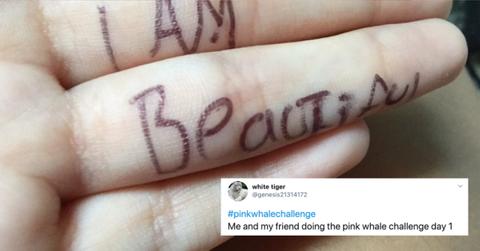People Are Now Doing the Pink Whale Challenge to Boost Positivity and Self-Love
Updated July 6 2020, 3:45 p.m. ET

Hi! Just so you know, this article discusses topics that some people may find disturbing, such as suicide and self-harm. Please find another article to read if you would rather not engage with this type of content. Thanks!
You may remember a few years back when something called the Blue Whale Challenge started making the rounds on the internet. Or, rather, when commentary about the challenge did, anyway. The Blue Whale Challenge was a social network phenomenon that consisted of a series of tasks that people participating in the challenge were supposed to complete within 50 days. The tasks started out innocuous enough but escalated into promoting self-harm and ultimately challenged participants to commit suicide.

Some say the Blue Whale Challenge is nothing but an urban legend, but Russian paper Novaya Gazeta reported that an estimated 130 teens had committed suicide as a result of the challenge. Now, there’s a new challenge that’s intended to counteract the Blue Whale Challenge. It’s called (appropriately enough) the Pink Whale Challenge, and it also consists of a list of tasks people have to do in order to participate — but they have a completely different intended outcome.
The Pink Whale Challenge is a list of things people can do to spread positivity.
The Pink Whale Challenge is meant to be a positive response to the harmful Blue Whale Challenge. It features things people can do in an attempt to improve their mood and enhance their feelings of self-worth. We’ll cover the actual list of tasks included in the challenge, but be aware that we’re not necessarily endorsing this challenge — as with all things on the internet, make sure to do your own research!
Here’s the full Pink Whale Challenge list of tasks:
Day 1: Write “I am beautiful” on your hand.
Day 2: Think about yourself, your friends, and your family.
Day 3: Listen to some relaxing music and go to bed early.
Day 4: Take a bubble bath and play with the bubbles.
Day 5: Draw a heart on your hand if you think your life is worth it. If not, “punish” yourself by going to bed early.
Day 6: Watch satisfying/relaxing videos.
Day 7: Do something that makes you happy.
Day 8: Have some dessert after a meal.
Day 9: Spend an hour outside watching the clouds.
Day 10: Write “I am worth it” on a piece of paper until you believe it.
Day 11: Stay up late doing whatever you want — eating, drawing, watching movies, etc.
Day 12: Smile at yourself and make silly faces in a mirror.
Day 13: Give somebody a good, long hug.
Day 14: Go to the mall or online shop (you don’t need to buy anything).
Day 15: Wake up early to watch the sunrise.
Day 16: Do your best on everything you do.
Day 17: Tell your family members you love them and give them a hug.
Day 18: Doodle hearts on your hand or on paper.
Day 19: Spend time with friends or family and take some time to meditate.
Days 20 – 49: Repeat previous days and be kind to yourself and others.
Day 50: Look in the mirror. Think about the past months. Look at how your life is worth it. Suicide is not the answer. You are loved. You have completed the Pink Whale Challenge.
Some people think the Pink Whale Challenge could still be harmful.
Hopefully this goes without saying, but participating in an online challenge — even one meant to spread positivity and happiness — is no replacement for speaking to actual mental health professionals if you are struggling. There are also some people who think certain tasks in the Pink Whale Challenge could be triggering to some people.
For some people, trying to stay positive when they’re feeling low is a good way to practice self-care. For others, though, it can actually be harmful. If you or someone you know is contemplating participating in the Pink Whale Challenge (or any similar challenges), it’s probably a good idea to reach out to your loved ones or a professional first.
If you or someone you know is contemplating suicide, call the National Suicide Prevention Lifeline at 1-800-273-8255.